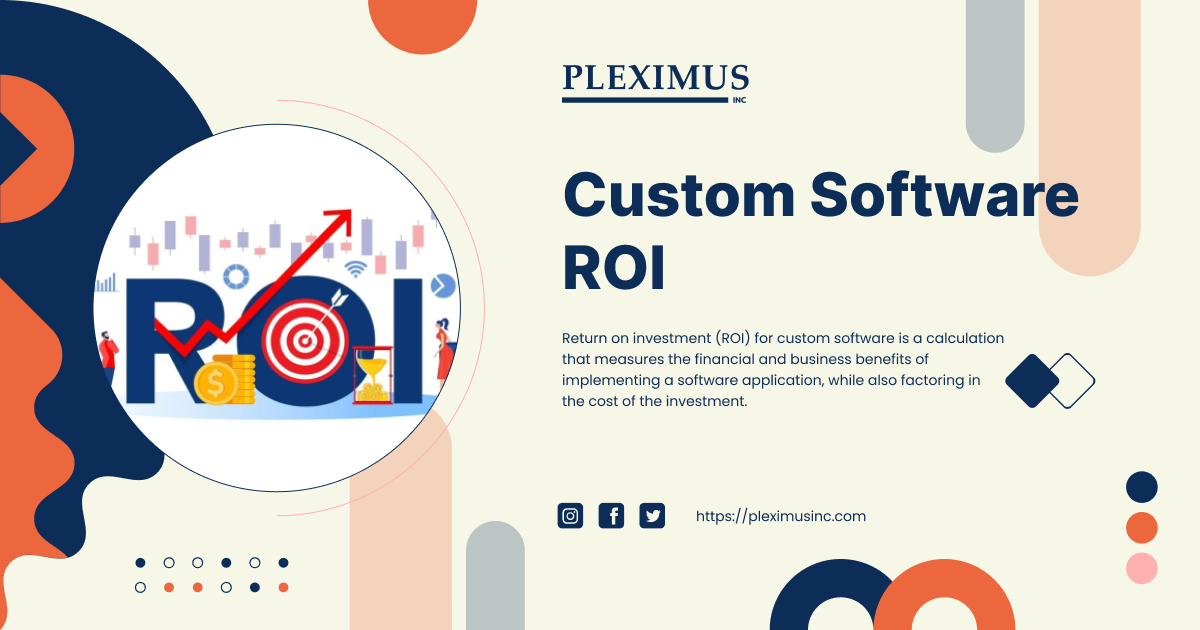Custom Software ROI
Discover strategic insights into custom software development ROI. Learn how to calculate ROI effectively and optimize your investment for maximum returns.

In today’s competitive landscape, businesses are increasingly turning to custom software solutions to achieve a higher return on investment (ROI). Developed specifically for a company’s unique requirements, custom software provides tailored functionality that off-the-shelf solutions often lack.
This approach not only addresses specific challenges but also opens new avenues for growth and efficiency. Understanding the ROI of custom software involves more than just analyzing immediate costs versus benefits.
It requires a strategic evaluation of how the software contributes to business objectives, such as increased productivity, better decision-making, and competitive advantage.
The true value of custom software lies in its potential to streamline operations, reduce manual tasks, and provide insights that drive strategic decisions.
Factors Affecting ROI in Custom Software Development
The upfront development cost impacts ROI directly, including planning, design, and implementation. The effectiveness of the software in improving processes, reducing errors, and enhancing productivity contributes significantly to ROI.
Several factors come into play when evaluating the ROI (Return on Investment) in custom software development. These factors influence both the initial investment and the potential returns over time.

Initial Investment
The Initial Investment refers to the amount of capital or resources put into a project or asset at the beginning of an investment period. It is the starting point for calculating ROI and is critical for understanding the overall effectiveness of an investment.
- Baseline for Evaluation: The initial investment is the baseline amount against which the returns are measured. It’s the reference point for calculating how much profit or loss was made.
- Investment Planning: Understanding the initial investment helps in planning future financial strategies, setting benchmarks, and making informed decisions about pursuing or continuing an investment.
- Performance Measurement: By comparing the returns generated to the initial investment, you can gauge the success of the investment and determine whether it met, exceeded, or fell short of expectations.
- Financial Analysis: Accurate tracking of initial investment is essential for conducting financial analyses, including profitability, cost-benefit analysis, and financial forecasting.

Time-to-Market
Time-to-market (TTM) refers to the duration it takes for a product or service to move from the initial concept phase to being available for customers. It encompasses all stages of development, from ideation to launch.
- Impact on Returns: Shorter TTM can lead to quicker revenue generation and faster ROI. The sooner a product reaches the market, the sooner it starts to generate returns on the initial investment.
- Competitive Advantage: Rapid time-to-market can help capture market share before competitors launch similar products, leading to better profitability and higher ROI.
- Cost Efficiency: Reducing TTM often involves streamlining processes and minimizing delays, which can reduce development costs and increase overall ROI.
- Market Demand: A faster TTM allows businesses to respond more effectively to market trends and customer needs, potentially enhancing returns and investment outcomes.

Calculating ROI with Time-to-Market
A faster TTM can improve ROI by increasing the net profit from an investment. The ROI formula remains:
ROI=Net ProfitInitial Investment×100
However, the net profit is influenced by how quickly a product can be brought to market and generate revenue.
Strategies for Improving Time-to-Market
- Streamlined Processes: Optimize development workflows to eliminate inefficiencies.
- Agile Methodologies: Use agile project management techniques for flexible and iterative progress.
- Cross-Functional Teams: Foster collaboration among different departments to speed up the development process.
- Technology and Tools: Implement advanced tools and technologies for faster development and testing.
Quality and Performance
Quality refers to the degree to which a product or service meets customer expectations and standards. Performance measures how well a product or service functions in achieving its intended goals.
- Customer Satisfaction: High quality and performance lead to greater customer satisfaction, which can drive repeat business, positive reviews, and referrals. This, in turn, can enhance the ROI by increasing revenue and market share.
- Cost Efficiency: Investing in quality can reduce long-term costs associated with returns, repairs, or customer service issues. High performance ensures that the product or service meets its objectives effectively, leading to better use of resources and improved ROI.
- Brand Reputation: Maintaining high quality and performance strengthens the brand's reputation. A strong brand can command higher prices and attract more customers, which positively impacts ROI.
- Competitive Advantage: High-quality products or services with superior performance can differentiate a business from competitors. This competitive edge can lead to increased sales and improved ROI.

Calculating ROI with Quality and Performance
ROI measures the financial return relative to the initial investment. Quality and performance affect ROI through:
- Higher Sales: Improved quality and performance can boost sales and revenue.
- Reduced Costs: Fewer defects and issues lead to lower operational costs.
- Better Market Position: Strong performance and quality enhance market share and pricing power.
ROI Formula
The standard ROI formula is:
ROI=Net ProfitInitial Investment×100
Where Net Profit includes gains from high-quality products or services and cost savings from efficient performance.
Metrics for Measuring ROI
Metrics for measuring ROI include Net Profit Margin (Net Profit/Initial Investment) and Return on Assets (ROA) (Net Income/Total Assets), which quantify financial performance and investment efficiency.

Cost Savings
Cost Savings refers to the reduction in expenses achieved through more efficient practices, technologies, or strategies. It involves cutting unnecessary costs to improve financial performance.
- Improved Profitability: Cost savings directly increase net profit by reducing expenses. This enhances the overall ROI by allowing a greater portion of revenue to contribute to profits.
- Enhanced Efficiency: Efficient cost management leads to better resource allocation and operational effectiveness, which can result in higher returns on investment.
- Competitive Pricing: Cost savings can enable businesses to offer competitive pricing while maintaining or improving profit margins, which can attract more customers and boost ROI.
- Investment Potential: Reduced costs free up resources for reinvestment into new opportunities or projects, potentially leading to additional revenue streams and improved ROI.
Measuring ROI with Cost Savings
Cost savings impact ROI through increased profitability and efficient resource use. To reflect this in ROI calculations, you can use the following formula:
ROI=Net ProfitInitial Investment×100
Net Profit increases as cost savings lower overall expenses, thereby boosting ROI.
Revenue Generation
Revenue Generation refers to the process of creating income through the sale of products, services, or other business activities.
- Direct Impact: Increased revenue boosts the net profit, which enhances ROI. More revenue means higher returns on the initial investment.
- Growth Opportunities: Strong revenue generation provides funds for reinvestment in growth initiatives, potentially leading to even higher ROI.
- Financial Health: Consistent revenue growth improves overall financial stability, which can attract investors and support long-term ROI objectives.
Measuring ROI with Revenue Generation
To calculate ROI, you use the formula:
ROI=Net ProfitInitial Investment×100
Net Profit increases with higher revenue, thereby improving ROI.
Higher revenue from effective marketing leads to a better ROI.
User Adoption and Satisfaction
User Adoption refers to the process of users beginning to use a product or service. User Satisfaction measures how pleased users are with the product or service they receive.
- Increased Revenue: Higher user adoption leads to more customers, which drives revenue growth. Satisfied users are more likely to make repeat purchases or subscribe to premium services, enhancing ROI.
- Reduced Costs: High user satisfaction reduces churn rates and support costs, leading to cost savings. Fewer issues mean lower customer service expenses and better ROI.
- Brand Loyalty: Satisfied users are more likely to recommend the product or service, creating positive word-of-mouth and expanding the customer base, which improves ROI.
- Market Position: High adoption rates and user satisfaction strengthen market position, allowing businesses to command better pricing and gain competitive advantages, positively affecting ROI.

Measuring ROI with User Adoption and Satisfaction
To reflect user adoption and satisfaction in ROI, you can assess how they impact the following:
- Revenue Metrics: An increased user base leads to higher sales or subscription revenue.
- Cost Metrics: Lower customer service costs due to higher satisfaction.
- Growth Metrics: Higher adoption rates lead to a larger market share and potential for future revenue.
Collaborate with the Premier Custom Software Development Firm
Collaborating with a Premier Custom Software Development Firm involves partnering with a top-tier software development company to design, develop, and implement software solutions tailored to your business needs, to achieve the best possible return on investment (ROI).
Collaborating with a premier custom software development firm offers significant advantages that contribute to achieving a strong ROI. These firms bring expertise, innovative solutions, and robust support mechanisms that ensure your software development project succeeds.
By understanding and leveraging these benefits, businesses can make strategic investments that yield long-term financial and operational rewards.
